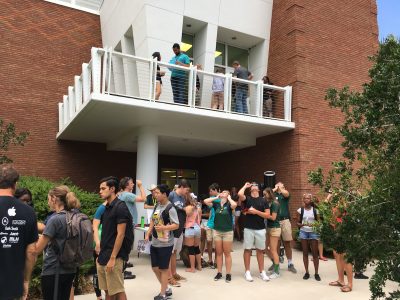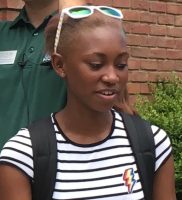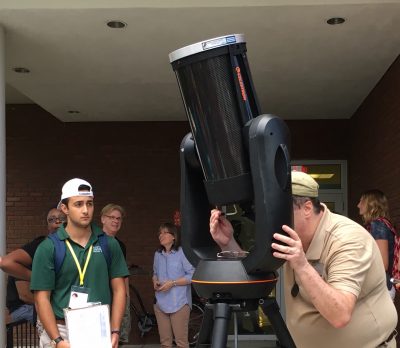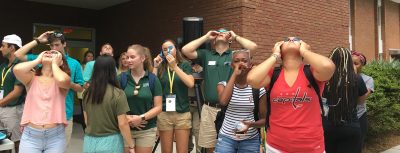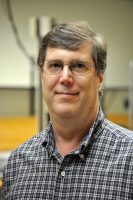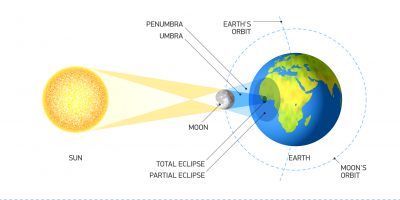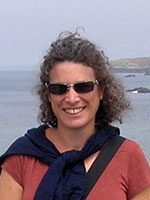
The FSEM Program at Stetson University was delighted to welcome over 50 FSEM instructors, teaching apprentices, staff, and administrators to the FSEM kick-off workshop of the 2017-2018 academic year. The following recap, provided by facilitators, captures the essence of activity and outcomes of the gathering.
Friday, August 18, 2017
Allen Hall
12:00-2:30 pm
11:30
Lunch Served
12:00 – 12:15 pm
Welcome
Noel Painter, Executive Vice President and Provost
Rosalie Richards, Associate Provost for Faculty Development
Provost Painter offered greetings and urged FSEM instructors and teaching apprentices to provide a distinctive experience for first year students. He highlighted that a taskforce or committee focused on core student learning will become integral to the FSEM Program. Dr. Painter also highlighted the FSEM Discovery Initiative, a pilot project focused on moving an undeclared major into a major.
Associate Provost Richards framed her remarks by reminding FSEM instructors of their responsibilitiy for creating classroom environments free of bias and hate. She read the first paragraph of a Dear Colleague letter penned by the former Secretary of Education and former Deputy Secretary and referenced Stetson University’s position of solidarity with the University of Virginia. She then provided an update of the FSEM Program.
Resources
Associate Provost Full Remarks
2017 FSEM Program Update
2017 FSEM TLI Report
12:15 – 12:30 pm
Goals and History of the FSEM Program
Megan O’Neill, Associate Professor of English and Director of the Writing Program
When we started the FSEM program, our faculty development meetings were brown bag lunches in the Faculty Lounge, and all 20 of us sat on mismatched chairs to share ideas, trade assignments, and talk about the intellectual work of the program for its students and the ways we translated our passion projects to the seminar parameters. Now, we meet in Allen Hall, and it’s barely big enough for us all.
Those early days were important in developing the heart and core of the program, but a number of questions had to be wrestled with:
- What is the FSEM’s purpose?
- Is it simply to help students transition from high school?
- Or is the FSEM supposed to be an intro to a discipline?
- Interdisciplinary? Quasi-disciplinary?
- Was it a place for students to learn note taking skills and how to ask for help when they needed it?
Then, as FSEM expanded, other questions came up: Is it solely a liberal arts course in A&S? What is a Business FSEM like? What about a Music FSEM? Where are the commonalities and how can we respect differences?
After a decade of thinking, developing, investing, teaching, refining, and measuring, I think we’re coming around again to study the nature of the FSEM. It’s a place where students come to experience the life of the mind, the world of ideas, where they learn about new perspectives, read engaging texts, discuss new ideas, and join the intellectual world of the university. And although we don’t talk about our goals in this kind of language, I think we are also trying to teach them the habits of mind: inquiry; curiosity; creativity; resilience.
12:30 – 1:00 pm
Student Success: Interactive Case Studies
FSEM Instructors partner with FSEM Teaching Apprentices to unpack student scenarios
Julia Metzker, Executive Director of Brown Center for Faculty Innovation and Excellence
https://twitter.com/browncenter_su/status/898818699376836608
Participants organized into three groups comprising teaching apprentices, and seasoned, proficient, and new FSEM instructors. Each group evaluated one of three situational case studies steeped in stereotypes and microaggressions in the classroom. Participants offered recommendations on how each case embraced bias or discrimination and offered suggestion for how the FSEM instructor could positively address or redress each situation.
Resources
Interactive Case Studies
1:00 – 2:30 pm
Breakout Sessions
Breakout #1: Getting Started: Aligning your assignments and assessments with FSEM learning outcomes
Target Audience: Novice FSEM Instructors
Colin MacFarlane, Director of Assessment and Operational Effectiveness (CLaSS)
Rajni Shankar-Brown, Associate Professor and Jessie Ball duPont Chair of Social Justice Education
This session was facilitated by Rajni Shankar-Brown and Colin MacFarlane for new FSEM instructors. Six instructors were in attendance as well as learning and information literacy librarian, Grace Kaletski-Maisel, and Leigh Ann Dunning, director of the Writing Center and associate director of the Writing Program. The breakout was originally designed as a workshop to align assignments with the FSEM learning outcomes: critical thinking, speaking, writing, information literacy, and integrative learning. However, it became immediately clear to the facilitators that addressing pressing questions about FSEM was more important. Additionally, several instructors had attended the FSEM Transformative Learning Institute in May where alignment of assignments was also discussed in considerable detail. Facilitators concluded that addressing immediate needs of the seminars (scheduled to meet within three days) was a more prudent use of time.
Questions were raised on a variety of topics including
- the mentoring role of the instructor
- expectations around individual meetings with students
- expectations of a community-building activity of a social and/or academic nature
- attendance policies and strategies for working with students who arrive after the FSEM has begun
- resources available from the duPont-Ball Library the Writing Center, and the Brown Center for Faculty Innovation and Excellence.
Best practices to address questions were offered by all participants and facilitators were able to confirm some policies or procedures and other strategies based on experience. A few of the instructors brought their syllabus and had questions on specific items, and all instructors voiced having general questions amidst of both excitement and anxiety, i.e. being this was their first time teaching an FSEM course. A request was made for more information about the University’s policy related to student travel and off-campus events as related to the community-building activity. Information will be made available to all FSEM instructors.
Additionally, instructors inquired about the $150 Class Experience Budget and asked for seminar experience ideas . Dr. Shankar-Brown recommended that instructors review their FSEM contract letter and contact Dr. Richards if there were any additional questions or needs. The facilitators shared ideas on how the funds could be used. Examples included but were not limited to taking students to DeLeon Springs and visiting the Sugar Mill, going bowling as a class, visiting a local museum, purchasing materials for in-class activities, and purchasing items to support a culminating project or celebration.
Breakout #2: Next Steps: Improving outcomes for students in your class
Target Audience: Proficient FSEM Instructors
Julia Metzker, Executive Director of Brown Center for Faculty Innovation and Excellence
The session started with participants introducing themselves with a short description of the FSEM they were preparing to teach. The breakout was originally designed around an activity for participants to map their syllabus to the learning outcomes and QEP priorities but plans were abandoned to deal with immediate concerns.
After a short free-write activity participants identified things they were most anxious about and the things they were most excited about, the session evolved into a free-flowing conversation to address some of the concerns. The themes that arose predominantly centered around making sure participants were meeting the expectations of the FSEM – an issue they found challenging because they are either unclear about those expectations or did not feel they could adequately address all of the learning outcomes. A secondary concern was engaging first-year students so they were active participants in class.
Two best practices arose from the conversation:
-
- Use the first five minutes of class to mimic the type of classroom engagement you want for the rest of the course; i.e., if your course is discussion-based, facilitate a discussion.
- Do not become overwhelmed with the many demands on the course. Focus on the top 3 skill development elements: writing, speaking and information fluency; some felt critical thinking was essential as well.
There seemed to be a variation about which (and to what degree) of the expectations from the Quality Enhancement Plan (QEP) were being integrated into the class. It was recommended that a forum be established for FSEM instructors to come to some consensus about which of the eight expectations (5 General Learning Outcomes and 3 QEP priorities) are most critical to the course and which are optional.
Breakout #3: Looking Forward Discussion: Where do we want to go? How do we get there?
Target Audience: Experienced FSEM Instructors
Megan O’Neill, Associate Professor of English and Director of the Writing Program
Ranjini Thaver, Professor of Economics and Director of Africana Studies
Approximately 10 seasoned faculty discussed the status of the FSEM program, in particular, its past, present, and its future.
Faculty agreed that the FSEM program began as a visionary program with the mission of introducing new Stetson students to the rigors of college life and encouraging them to begin the journey of opening hearts and minds (see Stetson Values). However, for the past two years, the seminar has become a chore-like course with the overriding themes of housekeeping and retention, rather than enlightenment. There was general consensus that the overt reliance on top-down faculty development and the resultant frustration among seasoned faculty has triggered resistance to teaching an FSEM.
The following recommendations were made:
- Remove the “student success” elements from course expectations
- Keep FOCUS separate from the first week of FSEM. Completely devote three days to FSEM. This will empower faculty to concentrate on introducing to students the rigors of college academic life while encouraging them to explore the knowable unknown. This may be an effective start to students’ journey in the safe space that is the university. Classes will be 2-hours (which is 80% of a week’s in-class time), giving students the space and time to complete rigorous assignments. Evening FSEM-wide required movies/documentaries with discussion led by several FSEM faculty may reinforce our Values Commitment
- Lighten the burden placed on faculty development for master teachers (i.e., folks with 8 or more FSEMs under their belts) by replacing workshops and unnecessary housekeeping meetings with opportunities for discussion amongst themselves.
- Develop an informal mentoring plan for seasoned faculty to work with new FSEM instructors. This idea parallels the university-wide mentorship meals-program that existed until recently. The idea would be that both the seasoned and newer faculty would learn from each other’s FSEM ideas and course structures during a well-deserved meal sponsored by the FSEM program
- Create FSEM circles or squares without professionalizing them by requiring applications and reports. Integrate this into the fabric of the program.
Seasoned FSEM faculty were clearly excited about effecting change to the program and hoped that suggestions will be considered and further deliberated by administrative leaders, and implemented in a timely manner.
2:00 – 2:30 pm
Report Out and Wrap-up
To close the workshop, each person provided a single word reflection. Some reflections are captured here:


 Colleagues:
Colleagues:

 This year’s R.E.A.D. (Reflect Engage & Affirm Diversity) book, “Allah, Liberty and Love” (2011), is written by Manji. Manji describes the book as an effort to “reconcile faith and freedom in a world seething with repressive dogmas.” One of the key teachings of Manji’s work and a universal theme in her book is “moral courage” or the willingness to question, speak up, and be a courageous global citizen in a world filled with inequities. To check out a description of her book, visit the following site or Amazon.
This year’s R.E.A.D. (Reflect Engage & Affirm Diversity) book, “Allah, Liberty and Love” (2011), is written by Manji. Manji describes the book as an effort to “reconcile faith and freedom in a world seething with repressive dogmas.” One of the key teachings of Manji’s work and a universal theme in her book is “moral courage” or the willingness to question, speak up, and be a courageous global citizen in a world filled with inequities. To check out a description of her book, visit the following site or Amazon.


